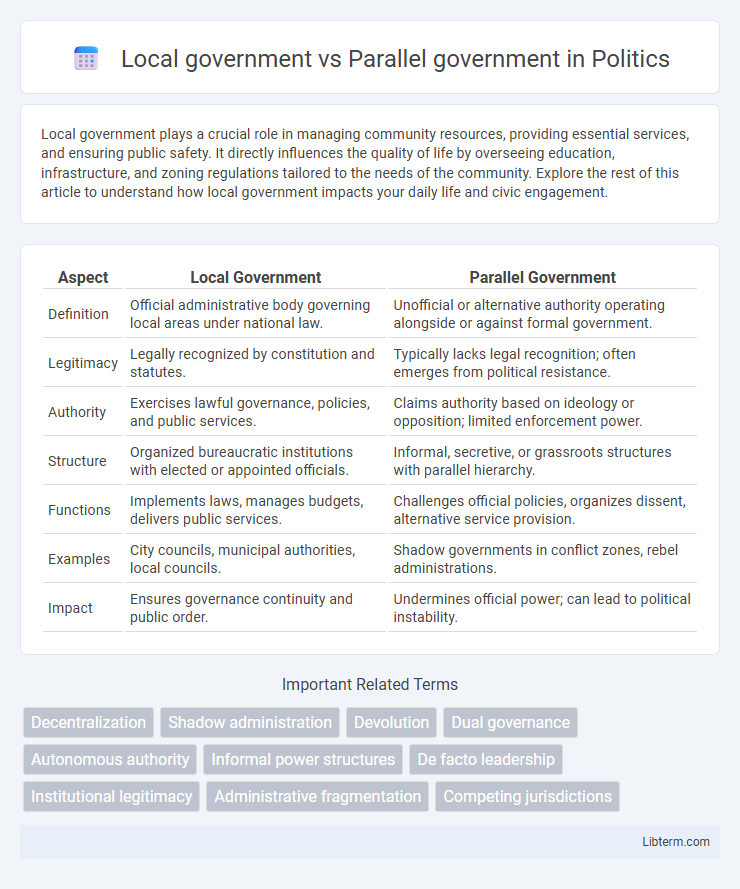Local government plays a crucial role in managing community resources, providing essential services, and ensuring public safety. It directly influences the quality of life by overseeing education, infrastructure, and zoning regulations tailored to the needs of the community. Explore the rest of this article to understand how local government impacts your daily life and civic engagement.
Table of Comparison
| Aspect | Local Government | Parallel Government |
|---|---|---|
| Definition | Official administrative body governing local areas under national law. | Unofficial or alternative authority operating alongside or against formal government. |
| Legitimacy | Legally recognized by constitution and statutes. | Typically lacks legal recognition; often emerges from political resistance. |
| Authority | Exercises lawful governance, policies, and public services. | Claims authority based on ideology or opposition; limited enforcement power. |
| Structure | Organized bureaucratic institutions with elected or appointed officials. | Informal, secretive, or grassroots structures with parallel hierarchy. |
| Functions | Implements laws, manages budgets, delivers public services. | Challenges official policies, organizes dissent, alternative service provision. |
| Examples | City councils, municipal authorities, local councils. | Shadow governments in conflict zones, rebel administrations. |
| Impact | Ensures governance continuity and public order. | Undermines official power; can lead to political instability. |
Introduction to Local Government and Parallel Government
Local government refers to officially recognized administrative bodies responsible for governing specific geographic areas within a country, such as cities, towns, or districts, with powers delegated by the central government. Parallel government describes unofficial or shadow administrations that operate alongside or outside the established government structure, often without formal legal authority. Understanding the distinctions between local government's statutory functions and parallel government's unofficial operations highlights the complexity of governance and political authority in various regions.
Definitions and Core Concepts
Local government refers to administrative bodies governing specific geographic areas such as municipalities, counties, or districts, responsible for delivering public services and enforcing local laws. Parallel government denotes unofficial or alternative power structures existing alongside official governments, often operating clandestinely or in opposition to recognized authorities. Core concepts include legitimacy and authority, where local governments derive powers from legal frameworks, while parallel governments challenge or bypass these systems to influence governance or control.
Historical Development and Context
Local government systems originated from medieval administrative units, evolving through feudalism into organized civic institutions that managed community affairs, taxation, and law enforcement within defined geographical boundaries. Parallel governments emerged primarily in colonial and revolutionary contexts as alternative power structures formed by resistance movements to challenge existing regimes, often operating clandestinely to provide governance and legitimacy. Historical developments show local governments institutionalizing authority under recognized sovereignty, while parallel governments represent contestation and socio-political mobilization against that authority.
Structure and Functions of Local Government
Local government operates as an officially recognized administrative division with elected officials responsible for public services such as education, sanitation, and law enforcement within defined geographic areas. Its structure includes councils, mayors, and departments that facilitate governance and policy implementation in accordance with national laws. In contrast, a parallel government functions unofficially or clandestinely, often forming alternative power centers that challenge the legitimacy of local authorities by providing rival services or political leadership.
Structure and Operations of Parallel Government
Parallel government operates through an alternative administrative system that mimics official local government structures but remains unofficial and often clandestine. Its structure typically includes shadow councils, independently appointed officials, and parallel service delivery mechanisms designed to challenge or bypass formal government authority. This alternative governance operates by mobilizing community support, managing resources, and executing administrative tasks without legal recognition, often arising in conflict zones or regions with weak local government presence.
Key Differences between Local and Parallel Governments
Local governments operate within the legal framework of a recognized state, providing public services and governance at municipal or regional levels, whereas parallel governments function outside official state authority, often established by insurgent or rebel groups to challenge or replace state control. Local governments are funded through official taxation and have structured electoral systems, while parallel governments rely on alternative revenue sources and informal or coercive methods of leadership selection. The legitimacy of local governments is usually recognized by both national and international entities, contrasting with the contested legitimacy and often clandestine nature of parallel governments.
Impact on Governance and Public Services
Local government promotes effective governance by ensuring decisions align with community needs, enhancing transparency and accountability in public service delivery. Parallel government structures often create overlapping authority and confusion, leading to inefficiencies and weakened service quality. This fragmentation undermines policy implementation and resource allocation, reducing overall governance effectiveness.
Legal and Constitutional Perspectives
Local governments operate within the legal framework established by national constitutions, deriving authority from laws and regulations that define their powers and responsibilities. Parallel governments function outside or alongside constitutional mandates, often lacking formal legal recognition and challenging the sovereignty of established state institutions. Legal perspectives emphasize the legitimacy and accountability of local governments, whereas parallel governments raise constitutional conflicts and issues of governance legitimacy.
Challenges and Controversies
Local governments often face challenges such as limited financial resources, bureaucratic inefficiencies, and political interference, which hinder effective service delivery and governance. Parallel governments, operating outside official frameworks, create controversies by undermining legal authority, fostering corruption, and perpetuating conflict through conflicting loyalties and unaccountable power structures. The coexistence of these entities frequently leads to jurisdictional disputes, weakened institutional legitimacy, and challenges in maintaining law and order.
Future Prospects and Recommendations
Future prospects for local government emphasize increased digital integration and community-driven policy-making to enhance transparency and responsiveness. Parallel governments, often operating outside official frameworks, risk perpetuating legal ambiguities and undermining democratic accountability unless clear regulatory mechanisms are established. Recommendations include strengthening institutional capacity in local governance while formalizing oversight of parallel entities to ensure alignment with national development goals.
Local government Infographic

 libterm.com
libterm.com